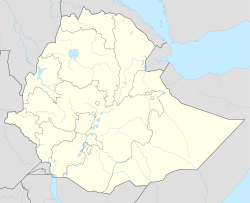Bambasi
|
Bambasi Abba Moti |
|
|---|---|
| Location within Ethiopia | |
| Coordinates: 9°45′N 34°44′E / 9.750°N 34.733°ECoordinates: 9°45′N 34°44′E / 9.750°N 34.733°E | |
| Country | Ethiopia |
| Region | Benishangul-Gumuz |
| Zone | Asosa |
| Elevation | 1,668 m (5,472 ft) |
| Population (2005) | |
| • Total | 7,166 |
| Time zone | EAT (UTC+3) |
Bambasi (also known as Abba Moti) is a town in western Ethiopia. The town is named after the highest point in the Asosa Zone of the Benishangul-Gumuz Region, Mount Bambasi. Bambasi has a longitude and latitude of 9°45′N 34°44′E / 9.750°N 34.733°E with an elevation of 1668 meters above sea level. It is the administrative center of Bambasi woreda.
Bambasi is located on the Gimbi-Asosa road, making the town one of the few in the Region accessible by motor vehicle with the rest of Ethiopia.
In the later 19th century, Bambasi was seat of the Sheikhdom of Bambasi, which had been established following the conquest of Ismail bin Muhammad Ali, son of Wali Muhammad Ali. Although it was a notorious center of the slave trade, by the 1880s the Sheikhdom derived a significant share of its revenue from taxing the salt trade between the rest of Sudan and the nearby Oromos.
A description of Bambasi in the Guido (published in 1938) describes it as consisting of three groups of houses at the base of Mount Bambasi, and supplied with abundant water and a market. The town was captured by the Oromo Liberation Front (OLF) on 7 January 1990, and six Cuban doctors and nurses were taken hostages after five days of heavy fighting. In response government aircraft subjected Bambasi to aerial attacks; details on the casualties are not available. The following month, the OLF clandestine radio reported that the group had killed 84 government soldiers in a clash between Bambasi and Mendi.
...
Wikipedia

